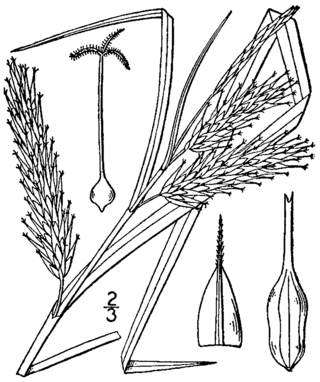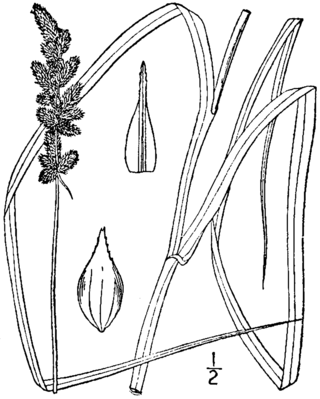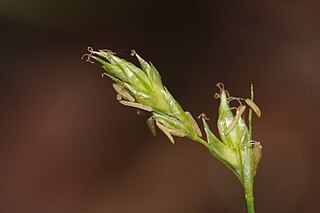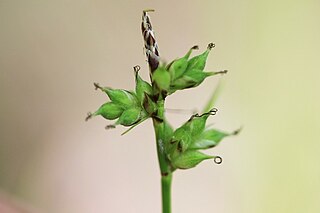Related Research Articles

The Cyperaceae are a family of graminoid (grass-like), monocotyledonous flowering plants known as sedges. The family is large: botanists have described some 5,500 known species in about 90 genera, the largest being the "true sedges" with over 2,000 species.

Carex nigra is a perennial species of plants in the family Cyperaceae native to wetlands of Europe, western Asia, north Africa, and eastern North America. Common names include common sedge, black sedge or smooth black sedge. The eastern limit of its range reaches central Siberia, Turkey and probably the Caucasus.
Georg Kükenthal was a German pastor and botanist who specialized in the field of caricology. He was the brother of zoologist Willy Kükenthal (1861–1922).

Carex pensylvanica is a species of flowering plant in the sedge family commonly called Pennsylvania sedge. Other common names include early sedge, common oak sedge, and yellow sedge.

Edward Groesbeck "Ed" Voss was an American botanist and expert on taxonomic nomenclature.

Carex lacustris, known as lake sedge, is a tufted grass-like perennial of the sedge family (Cyperaceae), native to southern Canada and the northern United States. C. lacustris us an herbaceous surface-piercing plant that grows in water up to 50 cm (1.6 ft) deep, and grows 50–150 cm (1.6–4.9 ft) tall. It grows well in marshes and swampy woods of the boreal forest, along river and lake shores, in ditches, marshes, swamps, and other wetland habitat. It grows on muck, sedge peat, wet sand or silt, in filtered or full sunlight.
Carex reznicekii, known as Reznicek's sedge, is a species of Carex native to North America. It is a perennial. Described initially from a New York population, this species was named in 2006 in honor of the botanist Anton Reznicek, a specialist in the genus Carex.

Carex davisii, known as Davis' sedge or awned graceful sedge, is a species of Carex native to North America. It is listed as an endangered, threatened, or species of concern across much of edge of its range. It was named in the 1820s by Lewis David de Schweinitz and John Torrey in honor of Emerson Davis (1798–1866), a Massachusetts educator and "enthusiastic student of the genus" Carex.

Carex schweinitzii, common name Schweinitz's sedge, is a Carex species native to North America. It is a perennial.

John Carey was a British botanist who studied in North America between 1830 and 1852. Carey was a "frequent guest and invaluable companion" to Asa Gray. Carey revised Gray's proofs of the first edition of the Manual of the Botany of the Northern United States, also contributing articles on Salix (willows), Populus (poplars), and Carex (sedges). In his obituary, Gray described Carey as "a near and faithful friend, an accomplished botanist, a genial and warm-hearted and truly good man."

Carex bromoides, known as brome-like sedge, brome-sedge, and dropseed of the woods, is a species of sedge in the genus Carex. It is native to North America.

Carex bicknellii, known as Bicknell's sedge and copper-shouldered oval sedge, is a species of sedge native to North America. Carex bicknellii grows in small clumps with fewer than 25 flowering stems per clump. It is found in mesic to dry prairies, savannas, and open woodlands.
Carex albolutescens, known as greenish-white sedge or greenwhite sedge is a species of sedge native primarily to the lower Midwest and Eastern United States. C. albolutescens grows in wetlands, with an affinity toward acidic soils in swamps and woodlands.

Carex bebbii, Bebb's sedge, is a species of sedge native to the northern United States and Canada. Carex bebbii grows in a variety of wetland habitats such as lakeshores, streambanks, ditches, meadows, swamps, and seeps. It forms dense tufts with culms up to 90 centimeters tall.

Carex brevior, known as shortbeak sedge and plains oval sedge, is a species of sedge native to North America. The specific epithet brevior means "shorter" in Latin.

Carex annectens, sometimes called yellow-fruited fox sedge, is a species of sedge native to most of the eastern United States and southeastern Canada. It is common in prairies and high-water table fallow fields. In the Chicago area, its coefficient of conservatism is 3, and in Michigan, it is only 1, indicating its relatively low fidelity to high quality habitats.
Peter William Ball is an English-born botanist, plant collector, and plant taxonomist, specializing in caricology.
William "Bill" J. Crins is a botanist, naturalist, and ecologist.

Carex deweyanaDewey's sedge, short-scale sedge, is a species of sedge native to Canada and the United States.

Carex peckii, Peck's sedge, Peck's oak sedge, or white-tinged sedge, is a species of sedge native to Canada and the United States.
References
- 1 2 3 4 "MNA Award Recognizes Excellence in Conservation Science". Michigan Nature Association. 2 November 2012. Retrieved 21 January 2024.
- ↑ "Index of Botanists". Harvard University Herbaria & Libraries. Harvard University. Retrieved 21 January 2024.
- 1 2 "Anton Reznicek". LSA Ecology and Evolutionary Biology. University of Michigan. Retrieved 21 January 2024.
- ↑ "Susan A. Reznicek". mlive. Retrieved 21 January 2024.
- ↑ "Speakers Tony Reznicek". Ontario Rock Garden & Hardy Plant Society. Retrieved 21 January 2024.
- ↑ International Plant Names Index. Reznicek.